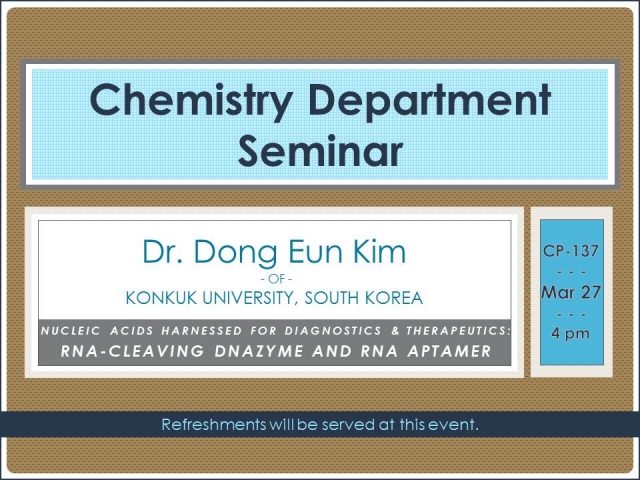Crystal growth and exotic magnetic transitions in rare earth orthoferrites RFeO3"
If time allows the speaker will also discuss
Exchange bias in Co/Ca2Ru0.98Fe0.02O4 heterostructure
If time allows the speaker will also discuss
Exchange bias in Co/Ca2Ru0.98Fe0.02O4 heterostructure
In this lecture/workshop, Dr. Donna Lee Kwon will introduce Korean music and facilitate its understanding by focusing on its unique characteristics. She will discuss traditional folk genres such as p'ungmul drumming, p'ansori, and folksongs but also bring out cultural continuities in Korean popular music as well. Come prepared to sing, dance and tap the rhythms of Korean music.
Have you ever thought about German culture? Do you want to know some cultural differences between colleges in Germany and the US? Are the grades any different? How are the teachers in Germany? The classes? College life? Dorms? Come to Kaffeestunde (Hour of Coffee) to hear about Germany's culture! Refreshments will be provided.
Hosted by the German Department and sponsored by the Cultural Diversity Festival.
Organic molecules such as tetracene crystallize into solids that can be semiconductors, metals, or even superconductors. Although they were first developed over half a century ago, it is only fairly recently that the considerable promise that organic semiconductors hold as materials for electroncs, display technologies, and solar cells has begun to be realized. Lightweight, flexible, and inexpensive, these materials offer an attractive balance between cost and performance, complemented by versatility, and functionally accomplished by means of molecular design. I will review the physics of organic semiconductors and describe how their electronic and optical properties can be utilized in a variety of applications.
Cosmic Microwave Background (CMB) is a vestige radiation generated during the Recombination era, some 390,000 years after the Big Bang, when the Universe had become transparent for the first time. Initial observations of CMB made by the Wilkinson Microwave Anisotropy Probe (WMAP) led to determining the age of the Universe. The mechanisms that drove the recombination have been discovered by using modeling of the primordial plasma and seeking agreement with the observations. The new Plank Surveyor Instrument launched in 2009 has been expected to produce data about the recombination era of an unprecedented accuracy, that require including better information regarding the basic atomic physics processes into the present models. In this talk, I will review the results for various Rydberg atom - charge particle collisions and establish their relative importance during the stages of recombination era, with respect to each other and to radiative processes. Energy changing and angular momentum changing collisions with electrons and ions are considered.
----------
Dr. Dong Eun Kim of Konkuk University will be presenting a seminar titled:
